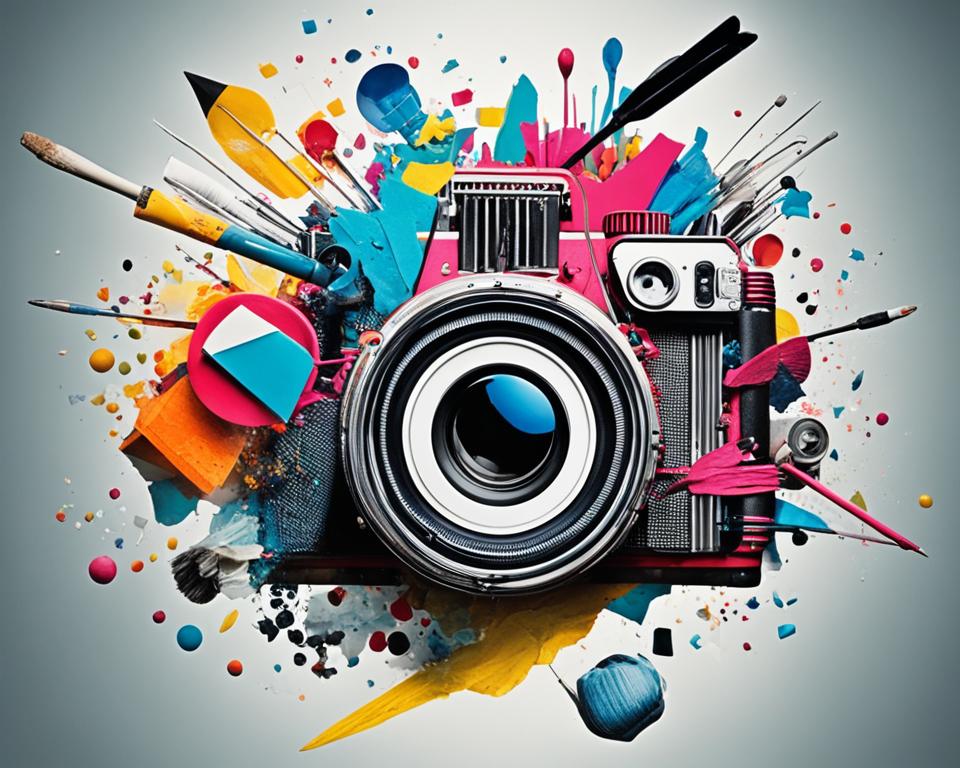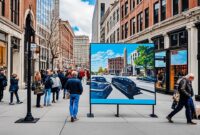Embark on an exhilarating journey through the dynamic world of contemporary art. This exploration will reveal the bold expressions and innovative techniques that define our era. We’ll delve into the vibrant landscape of contemporary art, showcasing the creativity of modern artists.
Discover the key characteristics and influential movements that shape the contemporary art scene. Gain insights into visionary talents who are redefining artistic expression. Learn how avant-garde artists and multimedia works challenge our perceptions and elicit deep emotional responses.
This article is designed for both art enthusiasts and newcomers. It will guide you through the realms of modern creativity, from local scenes to global art fairs. Prepare to be inspired, challenged, and transformed by the limitless possibilities of contemporary art.
Key Takeaways
- Explore the vibrant and ever-evolving world of contemporary art
- Discover the key characteristics and influential movements shaping modern artistic expression
- Gain insights into the visionary talents behind groundbreaking multimedia installations and conceptual art
- Uncover the impact of contemporary art on society and its ability to challenge our perspectives
- Navigate the art world as a collector and discover the future of this dynamic field
Understanding the Contemporary Art Landscape
Contemporary art is a realm of immense diversity, evolving continuously since the mid-20th century. It has redefined traditional art, challenging conventional notions and encouraging viewers to contemplate profound concepts. This evolution has led to a dynamic and multifaceted art world.
Defining Contemporary Art
Artworks from the 1960s onwards are classified as contemporary art, showcasing a plethora of styles, mediums, and themes. Unlike earlier art movements, contemporary art lacks a unified style or manifesto. It is characterized by its experimental nature, blurring traditional art boundaries and introducing novel forms of expression.
Key Characteristics and Themes
Several elements define contemporary art:
- Avant-garde Experimentation – Artists challenge traditional art norms, experimenting with unconventional materials and techniques.
- Conceptual Art – This art focuses on ideas and the viewer’s engagement, often eschewing traditional aesthetic objects.
- Social and Political Commentary – Contemporary art frequently addresses societal, cultural, and political issues, offering insights into the human condition.
- Interdisciplinary Collaboration – Artists often blend various disciplines, incorporating technology, performance, and sciences into their work.
Contemporary art’s diversity and dynamism encourage viewers to engage with challenging, thought-provoking works. These pieces often provoke and challenge our perceptions, expanding the horizons of artistic expression.
“Art is not what you see, but what you make others see.” – Edgar Degas
Avant-Garde Movements Shaping Modern Art
The contemporary art scene has been significantly impacted by avant-garde movements over the past century. These pioneering artistic approaches have challenged traditional norms, fostered experimentation, and expanded the definition of art. They have redefined the artistic landscape, offering fresh perspectives and innovative techniques.
Surrealism, a movement that thrived in the 1920s, stands out as a pivotal force. Artists like Salvador Dalí and René Magritte delved into the subconscious, creating dreamlike scenes that challenged rational understanding. Their work merged the tangible with the surreal, aiming to expose the human psyche’s hidden facets.
Following Surrealism, Abstract Expressionism became a significant force in the 1950s and 1960s. Artists such as Jackson Pollock and Willem de Kooning introduced a bold, gestural style. This approach emphasized the act of painting over representational accuracy, challenging traditional art conventions. Their large-scale, spontaneous works set the stage for future avant-garde movements.
The Pop Art movement of the 1950s and 1960s then turned its gaze to popular culture, transforming everyday objects into vibrant artworks. Artists like Andy Warhol and Roy Lichtenstein employed silkscreen printing and collage to critique consumerism and the impact of mass media on society.
These avant-garde movements have indelibly influenced contemporary art. By transcending traditional art forms and exploring new modes of expression, they have inspired countless modern artists. Their innovative spirit continues to shape the creative landscape, encouraging artists to push the boundaries of their craft.
| Avant-Garde Movement | Key Artists | Defining Characteristics |
|---|---|---|
| Surrealism | Salvador Dalí, René Magritte | Tapping into the subconscious, blending the real and the imaginary |
| Abstract Expressionism | Jackson Pollock, Willem de Kooning | Emphasizing the physical act of painting, spontaneous and gestural style |
| Pop Art | Andy Warhol, Roy Lichtenstein | Embracing imagery and iconography of popular culture, silkscreen printing, collage |
These avant-garde movements have not only reshaped modern art but have also significantly altered our perception of creativity. By challenging societal norms and expanding artistic possibilities, these visionary artists have ushered in a new era of artistic expression and innovation.
Multimedia Installations and Conceptual Art
In the realm of contemporary art, multimedia installations and conceptual art are revolutionizing traditional artistic forms. These innovative artworks challenge our perceptions, engaging us on a profound level. They often incorporate digital technologies, interactive elements, and immersive experiences.
Pushing Boundaries with New Media
Multimedia artists are venturing into a diverse array of mediums. They blend multimedia art, new media, and art installations to craft captivating works that exceed traditional boundaries. These artists are redefining our interaction with and conception of art through interactive digital projections and augmented reality experiences.
Thought-Provoking Concepts and Social Commentary
Conceptual art elevates this exploration, focusing on the ideas and messages behind the artwork rather than its physical form. Conceptual art addresses complex social, political, and philosophical themes. It challenges viewers to contemplate deeply and question their beliefs about the world.
| Multimedia Art Innovations | Conceptual Art Themes |
|---|---|
| Interactive digital installations | Social and political commentary |
| Augmented reality experiences | Philosophical exploration |
| Immersive audio-visual environments | Questioning societal norms |
By merging advanced technologies with profound concepts, contemporary artists are redefining art’s boundaries. They invite us to experience the world in novel and captivating ways.
“Art is not what you see, but what you make others see.” – Edgar Degas
Influential Contemporary Artists to Watch
In the realm of art, a new cohort of contemporary artists is captivating audiences and redefining creative boundaries. This group includes innovative painters and sculptors who are extending artistic expression and addressing profound themes. These visionaries are essential to observe as they shape the future of art.
Kehinde Wiley, a celebrated painter, is renowned for his vibrant, large-scale portraits. He reinterprets classical European art with a modern, diverse perspective. Wiley’s work celebrates marginalized communities, challenging traditional representation in art.
Ai Weiwei, a Chinese conceptual artist and activist, is another influential figure. His work often addresses social and political issues. Through multimedia installations and public interventions, Ai has tackled topics from human rights to the global refugee crisis, gaining international acclaim.
- Yayoi Kusama, the Japanese artist, is famous for her immersive, polka-dot environments. These works explore themes of obsession and infinity.
- Banksy, an anonymous British street artist, is known for his subversive and satirical works. His murals and installations have become symbols of contemporary art and social commentary.
- Barbara Kruger, an American artist, is recognized for her bold, text-based works. Her art confronts consumerism, feminism, and power structures.
These artists, among many others, are captivating audiences and defining the future of art. By engaging with their diverse practices and thought-provoking works, art enthusiasts can deepen their understanding of modern creativity’s vibrancy and evolution.
Exploring Art Galleries and Exhibitions
In the vibrant world of contemporary art, galleries and exhibitions are pivotal for discovering new creative expressions. They range from local art scenes to renowned international art fairs and biennales. These platforms offer enthusiasts a chance to delve into the captivating realm of modern creativity.
Discovering Local Art Scenes
Exploring local art scenes is a treasure trove of unique discoveries. Community-driven galleries often showcase emerging artists, providing a platform for fresh perspectives and innovative techniques. These intimate spaces foster a sense of connection, allowing visitors to engage directly with the creators and gain a deeper understanding of their art.
Moreover, cities host vibrant art exhibitions that celebrate the diverse talents within the local community. These events, ranging from group showcases to solo presentations, offer art lovers the opportunity to witness the evolution of contemporary art and support the growth of regional artistic talent.
International Art Fairs and Biennales
On a global scale, the art world comes alive through art fairs and biennales. These prestigious events attract art enthusiasts, collectors, and industry professionals from around the world. They provide a platform for the exchange of ideas and the discovery of cutting-edge artistic expressions.
From the iconic Art Basel in Switzerland to the Venice Biennale in Italy, these international art gatherings are hubs of innovation and inspiration. Visitors can immerse themselves in a wide range of multimedia installations, conceptual artworks, and thought-provoking social commentaries that push the boundaries of contemporary art.
“Art is not what you see, but what you make others see.” – Edgar Degas
Whether exploring local art scenes or engaging with global artistic movements, the journey through contemporary art galleries and exhibitions promises to ignite the senses and inspire a deeper understanding of the world around us.
Contemporary Art and Its Impact on Society

Contemporary art has evolved into a potent tool for social critique, challenging prevailing norms and artistic conventions. Artists employ their medium to illuminate pressing societal issues, encompassing social injustice, political turmoil, environmental degradation, and cultural identity.
Through innovative installations, multimedia displays, and conceptual art, contemporary artists initiate profound discussions and encourage viewers to contemplate their surroundings. Their works act as a stimulus for social transformation, prompting individuals to challenge their preconceptions and participate in meaningful dialogue.
The significance of art criticism in contemporary discourse cannot be overstated. Critics offer crucial insights, dissecting the underlying sociopolitical themes within artworks. Their analyses and critiques facilitate a deeper comprehension of the art’s complexities, guiding the audience towards a more nuanced appreciation of these avant-garde expressions.
“Art is not a mirror held up to reality, but a hammer with which to shape it.”
– Bertolt Brecht
The impact of contemporary art on society is intensifying. By subverting societal norms, fostering critical thought, and amplifying the voices of underrepresented groups, these artistic endeavors are catalyzing significant change. They are reshaping our collective perception of the world, offering a more inclusive and empathetic understanding of our reality.
Navigating the Art World as a Collector
For those passionate about art, the contemporary art world offers both excitement and challenges. Whether you’re an experienced collector or a newcomer, grasping the essential aspects of contemporary art investment is vital. This section will explore the elements affecting artwork value and demand. It will also provide advice on constructing an art collection that mirrors your taste and artistic interests.
Investing in Contemporary Art
Contemporary art investment demands a sharp eye, deep market knowledge, and a readiness for risk. The artist’s stature, the work’s rarity, and its historical importance significantly influence its value. By keeping abreast of emerging trends and monitoring new artists, you can spot investment chances and benefit from the dynamic contemporary art scene.
Building a Meaningful Collection
Creating a contemporary art collection should aim to gather works that are both valuable and personally meaningful. Art collecting transcends mere financial gain; it’s about forging a deep bond with the art itself. By selecting works that resonate with your interests and artistic tastes, you craft a collection that mirrors your unique viewpoint. This collection becomes a source of inspiration and personal satisfaction.
| Investing Considerations | Collection Building Strategies |
|---|---|
|
|
With a strategic approach and a profound appreciation for contemporary art, you can forge a collection. This collection will not only possess financial value but also embody your personal identity and artistic fervor.
The Future of Contemporary Art
The horizon of contemporary art beckons with an era of both allure and transformation. Emerging technologies, notably augmented and virtual reality, are set to revolutionize artistic creation and consumption. Trends such as eco-conscious art and the burgeoning role of digital platforms will sculpt the future of art, aligning with the evolving cultural and societal landscapes.
Artists, galleries, and institutions worldwide are navigating these shifts, adopting novel mediums and methodologies to expand creative horizons. The proliferation of immersive installations and interactive artworks will persist in redefining traditional art paradigms, engaging viewers as integral participants in the artistic narrative.
Furthermore, contemporary art’s future is forecasted to place a heightened emphasis on social and environmental awareness. Artists are leveraging their platforms to spotlight critical global concerns, including climate change and social justice, thereby initiating impactful dialogues and catalyzing positive transformations. This evolution towards art as a vehicle for social influence will significantly influence the art world’s trajectory.





